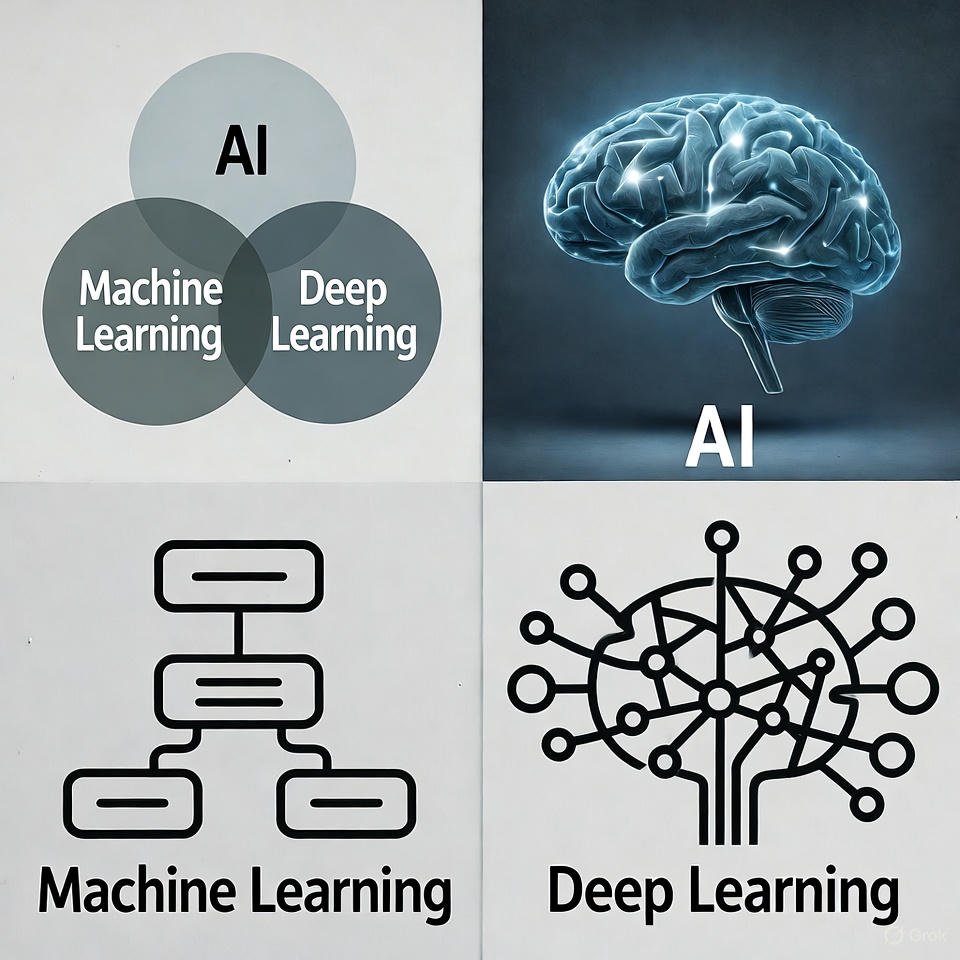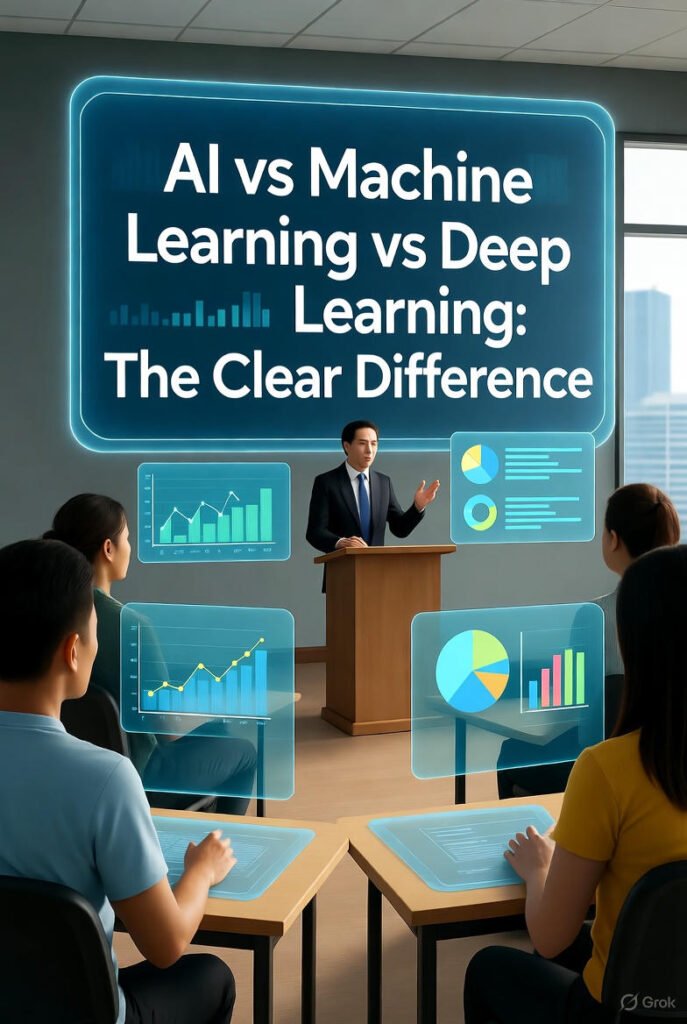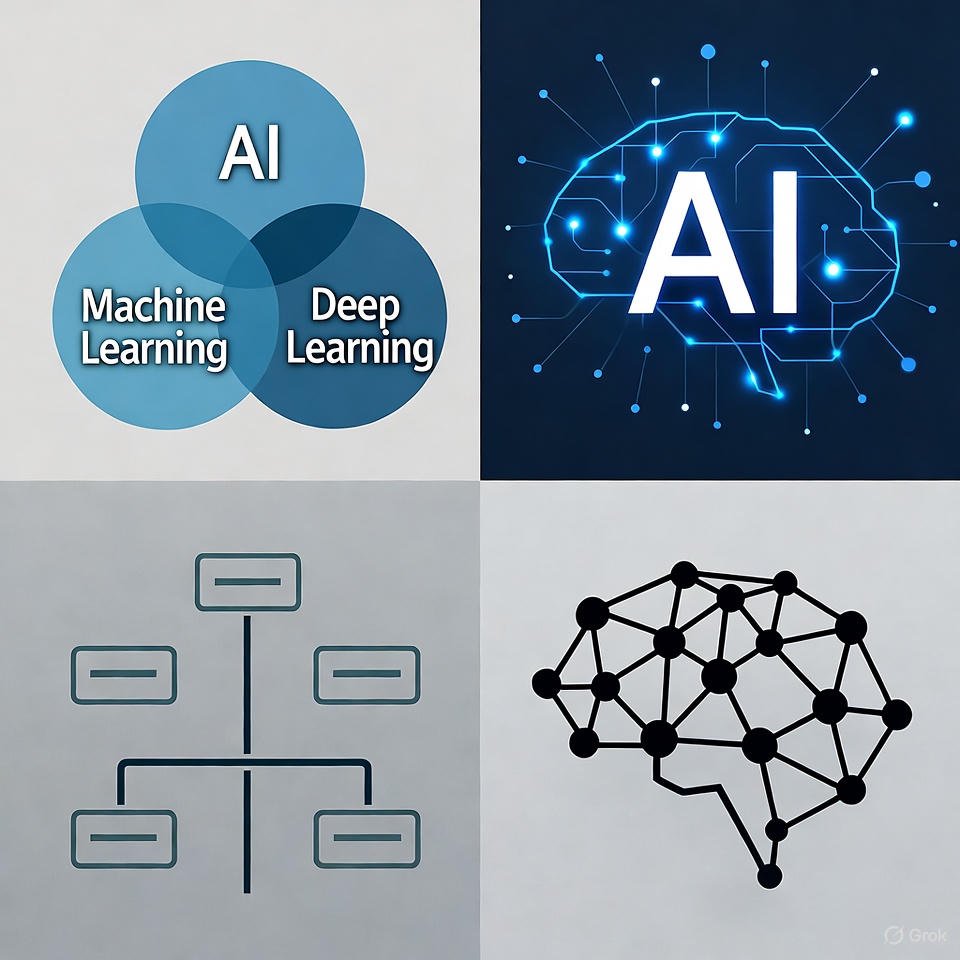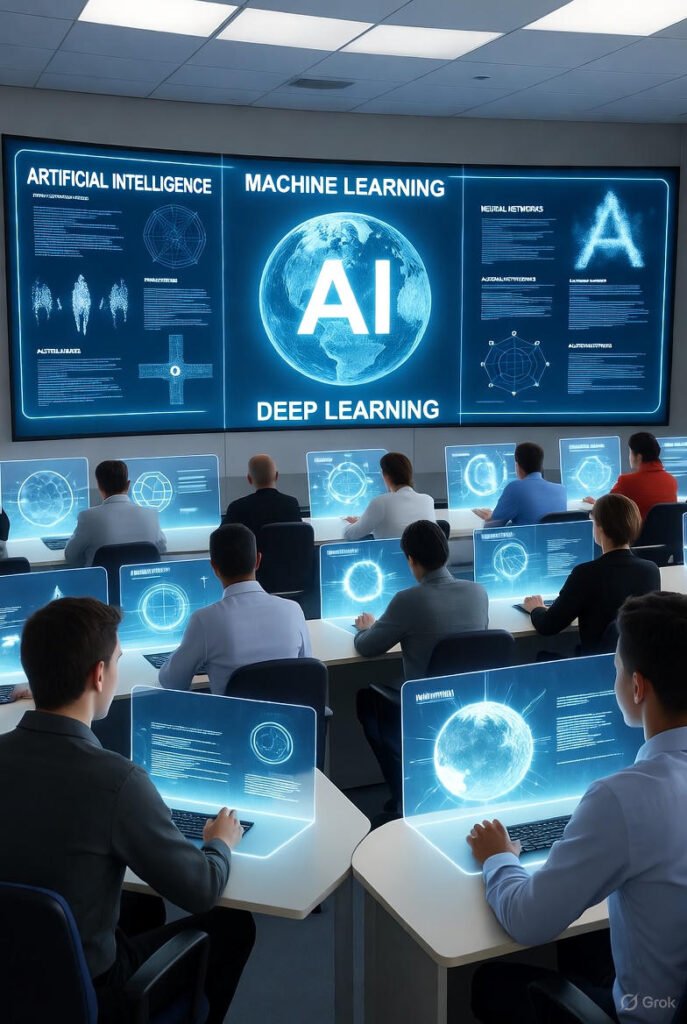
Introduction: Why Everyone Mixes Them Up
If you’ve ever heard people using AI, machine learning, and deep learning as if they were the same thing — you’re not alone. In tech conversations, these buzzwords often get tossed around interchangeably, creating confusion even among professionals.
But here’s the truth: while all three are closely related, they aren’t the same. Think of them as layers of a cake — Artificial Intelligence (AI) is the big picture, Machine Learning (ML) is a subset of AI, and Deep Learning (DL) is a specialized branch of ML that takes things to another level.
In this guide, we’ll break down the difference between AI, Machine Learning, and Deep Learning in simple terms, explore real-world examples, and help you understand where each technology truly fits in today’s world.
1. Understanding Artificial Intelligence (AI)
What is AI?
Artificial Intelligence refers to machines or systems that mimic human intelligence to perform tasks such as problem-solving, reasoning, learning, and decision-making.
The idea behind AI is simple — create machines that can “think” like humans. But in practice, it involves a complex blend of algorithms, data processing, and computational power.
Key Characteristics of AI:
- Learning: AI systems can improve over time with more data.
- Reasoning: They can make decisions based on logic and probabilities.
- Perception: AI can understand the world through sensors or input data (like images or voice).
- Interaction: Many AI systems communicate naturally with humans (think Siri or Alexa).
Types of Artificial Intelligence
AI is broadly categorized into three types based on capability:
- Narrow AI (Weak AI): Designed for specific tasks like facial recognition, language translation, or spam detection. (Example: Google Assistant)
- General AI (Strong AI): A still-theoretical form of AI that can understand, learn, and apply knowledge across multiple domains like a human.
- Super AI: A futuristic form that could surpass human intelligence — still in the realm of science fiction.
Examples of AI in Daily Life
- Smart assistants (Siri, Alexa, Google Assistant)
- Netflix and Spotify recommendations
- Chatbots for customer service
- Navigation systems like Google Maps
- Fraud detection in banking
2. What is Machine Learning (ML)?
The Core of AI
If AI is the big concept, Machine Learning is the engine that powers most modern AI systems. ML allows computers to learn from data without being explicitly programmed. Instead of giving step-by-step instructions, we feed the machine data, and it finds patterns to make predictions or decisions.
How Machine Learning Works
- Data Collection: Gather relevant information (e.g., emails, images, numbers).
- Training: Feed the data into an algorithm so the system can learn patterns.
- Testing: Use new data to test how well the model performs.
- Prediction: Once trained, the system can make accurate predictions on new data.
Machine Learning Algorithms (Simplified Examples):
- Supervised Learning: The system learns from labeled data.
Example: Predicting house prices based on past sales. - Unsupervised Learning: The system finds hidden patterns in unlabeled data.
Example: Customer segmentation in marketing. - Reinforcement Learning: The system learns by trial and error.
Example: Teaching a robot to walk by rewarding successful moves.
Machine Learning in the Real World
- Email spam filters
- YouTube and Amazon recommendation engines
- Predictive text and auto-correct
- Credit scoring and fraud detection
- Predictive maintenance in manufacturing

3. Deep Learning (DL): The Next Level of ML
What Makes Deep Learning Different
Deep Learning is a subset of machine learning inspired by how the human brain works. It uses artificial neural networks — layers of algorithms designed to recognize complex patterns.
While traditional ML needs structured data (like spreadsheets), deep learning thrives on unstructured data such as images, audio, and text.
Neural Networks Simplified
Imagine neurons connected in layers.
- The input layer receives data (like pixels from an image).
- Hidden layers process and learn features (like edges, colors, shapes).
- The output layer gives the final result (e.g., “This is a cat”).
Why Deep Learning is Powerful
Deep learning models can:
- Analyze millions of parameters automatically.
- Improve accuracy with more data.
- Handle complex and high-dimensional data.
Examples of Deep Learning
- Face recognition on smartphones
- Voice assistants (speech recognition)
- Autonomous vehicles
- Medical image diagnostics
- Deepfake and image generation tools
4. AI vs Machine Learning vs Deep Learning: The Key Differences
Let’s simplify everything in one place.
| Feature | Artificial Intelligence | Machine Learning | Deep Learning |
|---|---|---|---|
| Definition | Machines simulating human intelligence | Subset of AI that learns from data | Subset of ML using neural networks |
| Goal | Enable reasoning, learning, and decision-making | Learn from data to predict outcomes | Automatically learn complex patterns |
| Data Dependency | Works with structured or rule-based data | Needs structured data | Works best with large unstructured data |
| Human Intervention | High (rules, logic setup) | Moderate (feature selection) | Low (features auto-learned) |
| Examples | Chatbots, game AI, self-driving cars | Email filtering, recommendation systems | Face recognition, voice assistants |
| Hardware Needs | Low to moderate | Moderate | Very high (GPUs, TPUs) |
Visual Analogy
- AI = The whole universe
- ML = One galaxy inside it
- DL = A star system within that galaxy
Each level narrows the scope but deepens the capability.
5. How These Technologies Work Together
AI, ML, and DL are not competitors — they complement each other.
For example:
- AI sets the goal: “Build a self-driving car.”
- ML develops models that learn to detect obstacles, lanes, and signs.
- Deep Learning powers the computer vision and decision-making that let the car drive safely.
Without ML and DL, AI would remain a theoretical concept. And without AI, ML and DL would lack a broader purpose.

6. Real-World Applications and Use Cases
AI Applications
- Healthcare diagnostics and treatment suggestions
- Smart home automation
- Virtual customer service agents
- Game AI (like NPC behaviors in games)
Machine Learning Applications
- Predicting stock market trends
- Detecting fraudulent transactions
- Product recommendations on e-commerce websites
- Sentiment analysis on social media
Deep Learning Applications
- Self-driving cars (Tesla, Waymo)
- Real-time language translation
- Image and voice recognition
- Medical image classification (like detecting tumors)
7. Challenges and Limitations
Challenges with AI
- Ethical issues (bias, privacy concerns)
- Lack of transparency (AI “black box” problems)
- Job displacement fears
Machine Learning Limitations
- Requires large, clean datasets
- Model interpretability can be hard
- Prone to overfitting (performing well on training data but poorly in real-world use)
Deep Learning Drawbacks
- Needs vast amounts of data and computing power
- Hard to explain why a model made a certain decision
- Training can be time-consuming and costly
8. The Future of AI, ML, and DL
The future lies in hybrid intelligence, where human creativity and artificial intelligence work hand in hand.
Here’s what’s on the horizon:
- Explainable AI (XAI): Making AI’s decisions more transparent.
- Edge AI: Bringing intelligence to devices (like smartwatches or IoT sensors).
- Automated Machine Learning (AutoML): Simplifying model creation for non-experts.
- Generative AI: Creating text, images, and videos (like ChatGPT, DALL·E, or Midjourney).
As computing power grows and data becomes richer, the line between AI, ML, and DL will blur even more — but understanding their foundations will always matter.

9. Quick Recap: The Clear Difference
| Term | Description | Example |
|---|---|---|
| Artificial Intelligence | A system designed to mimic human intelligence. | Chatbots, game AI |
| Machine Learning | Algorithms that learn from data. | Netflix recommendations |
| Deep Learning | Neural networks that learn complex representations. | Face recognition |
10. How to Choose Between AI, ML, and DL for Your Project
If you’re a developer, startup founder, or data enthusiast — here’s a quick guide:
- Use AI when you need overall decision-making or automation (e.g., virtual assistants).
- Use ML when your system needs to learn from data to make predictions (e.g., sales forecasting).
- Use DL when your data is massive and unstructured — like images, videos, or speech.
Tip: Start simple with ML before jumping into deep learning. It’s faster, cheaper, and often good enough.
Conclusion: One Family, Three Generations
Artificial Intelligence, Machine Learning, and Deep Learning aren’t competitors — they’re part of the same evolutionary tree.
- AI gives machines intelligence.
- Machine Learning teaches them to learn.
- Deep Learning gives them the power to perceive and understand.
By understanding these distinctions, you’ll not only sound smarter in your next tech conversation but also gain clarity on which tools best fit your projects or career path.
The future of AI isn’t about replacing humans — it’s about empowering us to think bigger, act faster, and solve problems once thought impossible.
empowering
empowering